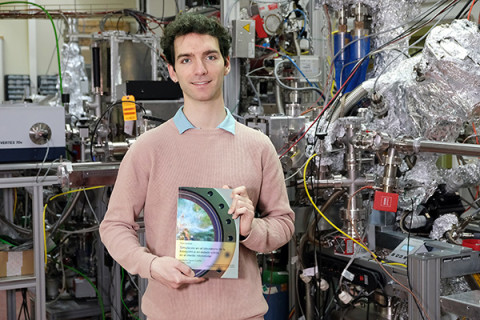Guillermo Tajuelo is defending his thesis: " I only see my future in science, within research and in a laboratory"

Guillermo Tajuelo is ending his work for the last years. On April 10, he is defending his PhD thesis at the Sala de Grados (module 8) of the Sciences Faculty at the Autonomous University of Madrid (UAM). His work, entitled 'Laboratory simulation of the solid-state photochemistry in the interestelar medium', has been supervised by José Ángel Martín-Gago at the Materials Science Institute of Madrid (ICMM-CSIC) and Gonzalo Santoro at the Institute of Structure of Matter (IEM-CSIC).
Tajuelo says that space "is not as empty as one might think": many molecules have been found, from simple to complex ones. "Besides stars and planets, we find other astronomical objects, such as nebulae and interstellar clouds," he describes. In these interstellar clouds, the density of particles (both gases and dust expelled by stars) is very high and the temperature is very low, "which causes the dust to be covered with ice mantles," he continues. "These ices reflect the evolution of the molecules that have been detected."
In this context, the research carried out by Tajuelo has focused on studying how composition changes when found in the conditions that occur in interstellar clouds, and more specifically in Dense Molecular Clouds, "which are the coldest and have the most chemical complexity," he adds.
"This research has the fundamental aim of providing more precise experimental data to theoretical models of chemical evolution in space," explains the young researcher, who also proposes reaction mechanisms involved, such as the gas-solid interaction during the irradiation of simple ice mantles. In this work, formation mechanisms of molecules that have not been previously observed are proposed, with examples of data that can be incorporated into theoretical models to improve their predictions of chemical evolution in space.
"I still remember how it all began," says the Tajuelo. "José Ángel was giving a seminar in the master's program I was doing, Applied Chemistry. At that time, he was the president of ASEVA, and he was looking for students to do a PhD with him. Then he introduced us to STARDUST, which at that time was beginning to yield its first results."
That was the moment when Tajuela chose ICMM for his PhD: "I chose ICMM and particularly to develop my PhD in the ESISNA group because, besides being an interdisciplinary group where knowledge from different experts in each scientific branch is coordinated, it gave me access to a unique facility: STARDUST. This opportunity to apply and expand my knowledge as well as to establish STARDUST as an international large facility motivated me to choose ICMM."
Now, once his work is done, he thinks about the lessons learnt at the ICMM: "As a chemist by training, I have learned that certain chemistry cannot take place in a conventional flask, but sometimes requires a more sophisticated vessel... So sophisticated that it's no longer made of glass but of steel, with windows both tiny and giant that never allow you to see exactly where you need to, where you have to tighten countless screws and nuts, and only after waiting several days will you know that everything has gone well," he says. And it is not the end: "That's just the beginning; now you have to make sure that your eyes inside the steel (connected instruments) function properly and that you can perform the experiment you want. All of this increases the risk that something will turn out the opposite of what you expected."
Talking about expectations, the young researcher says: "What I value most is the growth in both perspective and expectations of what I've accomplished. Sometimes you're struggling for days and other times for years to justify that the resulting outcome is what you say it is."
Asked about how he thinks this experience will contribute to his training and his future, Tajuelo says: "During the development of my doctorate, I have faced new challenges, through which, along with my knowledge, allowed me to calibrate different STARDUST instruments such as radiation sources (UV discharge lamp, ion gun...) as well as repair them (replacement of X-ray anodes, repair of vacuum pumps refrigeration system...) and gain significant experience in vacuum systems and how to diagnose them". Yes, because "a system is never completely empty".
This week he is focused on defending his thesis, but the future doesn't wait. "I'm currently waiting for the stabilization positions to be resolved (the thesis has been very long) while I'm trying to publish all the results I've obtained in my thesis since I've only been able to publish a couple of them in journals. But I only see my future in science, within research and in a laboratory."
Instituto de Ciencia de Materiales de Madrid (ICMM)
Sor Juana Ines de la Cruz, 3
Cantoblanco, 28049
Madrid, España
Telephone: (+34) 91 334 90 00
Email: @email
Communication Office: @email

Acknowledge the Severo Ochoa Centres of Excellence program through Grant CEX2024-001445-S/ financiado por MICIU/AEI / 10.13039/501100011033

Contacto | Accesibilidad | Aviso legal | Política de Cookies | Protección de datos